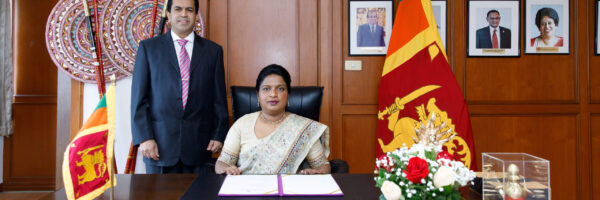The Grand Duchy of Luxembourg: A Culinary Story
Story by Kathleen Pokrud
Photo by Jenny Chan
Foreword
I was delighted when I heard that Kathleen intended to publish an article about Luxembourgish cuisine. Is there a better way to present a country or fall in love with a nation than through gastronomy? We are what we eat and the soul of a nation can best be understood through its cuisine. Culinary traditions and national dishes tell us a lot about the history of the people who invented them, adapted or adopted them and passed them on through generations.

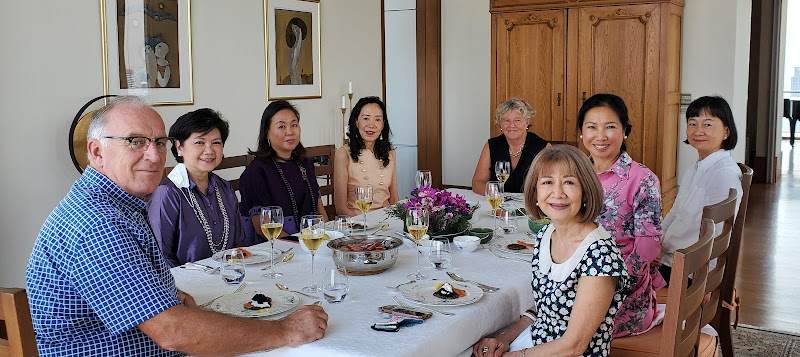
Geography has put my country in the middle of Europe, at the crossroads of Germanic and French cultures and influences. No wonder our cuisine incorporates both traditions. Foreign influences have been plentiful as Luxembourg has been a country of immigration since the very beginning of the industrialization at the end of the 19th century. The new citizens from Italy, Portugal and Spain have added a refined Mediterranean touch to the more rustic dishes passed down through generations of farmers and artisans. Today and thanks to a dynamic services sector, my country has developed into a truly cosmopolitan melting pot with half of our population holding foreign passports. This has not only added new smells and new tastes to our cuisine but also strengthened culinary culture and the joy of sharing cooking traditions. Most of our friends are ardent and enthusiastic hobby cooks and proud to share their recipes. The love of my fellow citizens for excellent food is perhaps best illustrated by the fact that Luxembourg holds the highest concentration of Michelin stars per capita in Europe. The first Woman Chef to receive “le Bocuse d’Or” the highest distinction in the world of cuisine – named after French Master Chef Paul Bocuse, was awarded to Léa Linster of Luxembourg already in 1989 – after she got her first Michelin star in 1987.
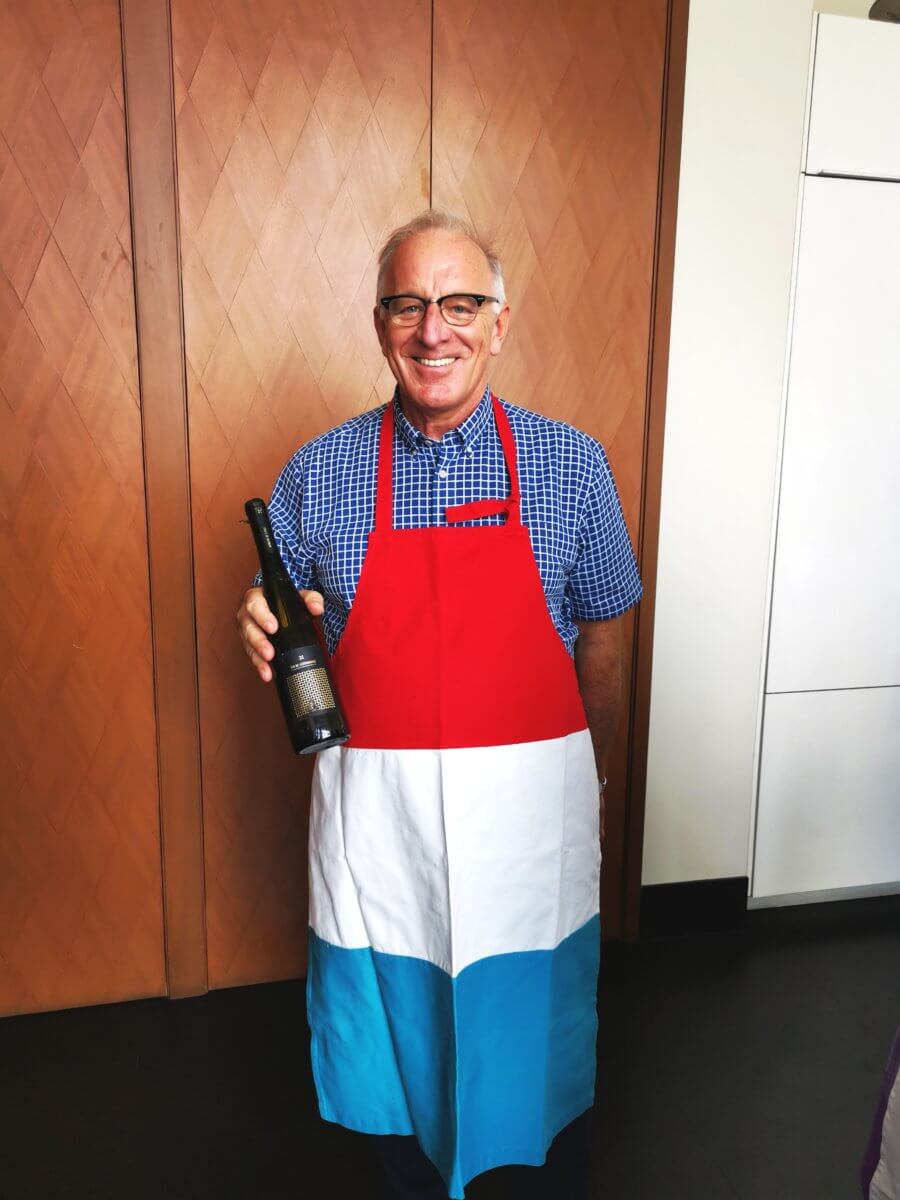
The love for fresh and tasty ingredients is perhaps what best defines our cooking. As a result, once you are in Luxembourg, be it in a restaurant or around a family table you are immersing yourself in the culinary traditions of Europe. As in every true melting pot and multicultural society, these traditions do however not simply coexist side by side but together they create something new and exciting while never denying their origins.
Therefore, I am happy that Kathleen wrote about Luxembourgish food, both traditional and at the same time a delightful fusion of European influences and Mediterranean refinement and always open to new experiences and adventures.
I do hope that you enjoy reading this article and rest assured, if ever you feel the craving of wanting to visit the place that produced this wonderful dishes, we will not only make you feel very welcome. You will feel at home.
Jean-Paul Senninger
Ambassador
GRAND DUCHY OF LUXEMBOURG
Embassy in Bangkok
Luxembourg is a cosmopolitan country in the heart of Europe. What shall visitors expect from the cuisine of the Grand Duchy of Luxembourg’s capital as a multicultural country? I was invited by Madame Louise Åkerblom, spouse of HE Jean-Paul Senninger, Ambassador of the Grand Duchy of Luxembourg to the Kingdom of Thailand, for a food demonstration at her residence to learn about Luxembourgish dishes.
Family bistro or gourmet restaurants, Luxembourg offers a varied array of cuisine with a fabulous mix of cultures and flavours. Many of Luxembourg’s traditional cuisine reflect the Grand Duchy’s farming heritage and location between Germany, France and Belgium. The different immigrant communities from all over Europe and beyond also influence their food.
Madame Louise explained the history of Luxembourg cuisine: “Traditional Luxembourg food reflects the geographical position between France and Germany, between Latin and Germanic countries. In the 20th century however, with large immigration from Italy and Portugal, the contemporary Luxembourg cuisine became a melting pot of intertwining influences.
The residing population is almost at a 50/50 rate of Luxembourgers and non-Luxembourg nationals. Most traditional Luxembourg dishes are of peasant origin. This reflects the heavier labour-intensive origins of the country, in mining and agriculture.
We like to joke that it combines the best of German (quantity) with French (quality). Today, with our economy dominated by the service industry, the cuisine has become more sophisticated, lighter and very varied. Environmental issues also influence more and more – locally produced, organic and vegetarian is now part of the menu in most restaurants.”
Madame Louise added further, “It would probably be hard to find a Luxembourg Restaurant somewhere else, but in the neighbouring regions you can find some special dishes on the menu. In the US Midwest, where there is a relatively large community of Luxembourg people, there are restaurants that proudly display a Luxembourg heading on their menu alongside seasonal food festivals.”
The Mosel region with its white wine has definitely inspired the nation’s national cooking. Many dishes from other countries have a Luxembourg take. The French Coque au vin –is in Luxembourg coque au Riesling (i.e. with white wine).
The Belgian mussels – served in wine or cream sauce – well in Luxembourg it is wine AND cream. The Italian Cappuccino has whipped cream on top instead of steamed milk.
You can find Thai spices in a “Bouneschlupp”- a traditional soup with green beans, potatoes, bacon or pork sausage. Italian tomato sauce waltzes with “Kniddelen” – our potato dumplings. You will also discover Indian curry in a “Rieslingspaschteit” – a meat paté in dough form.
Luxembourg has a lot of seasonal dishes, or special foods for different holidays. Very popular in early spring is a salad dish made from the pale parts of the Daffodil leaves, then comes White Asparagus – the thicker the better – with hollandaise and cured ham. Rhubarb tart is also a quintessential food of springtime. The heavier dishes with potatoes and cabbage are more winter comfort food.

Popular Luxembourg Dishes
The country’s cuisine combines rustic German heartiness, French finesse and a little Iberian flavour for good measure. Dishes often incorporate meat, fish, potatoes, dashes of cream, and wine.
Gromperekichelcher is a potato cake, or patty, with onions and parsley, often served with applesauce. One of the most popular foods in Luxembourg, these delicious crispy fried potato cakes can be found on sale at markets or fairs almost everywhere throughout the country. Grated potatoes, chopped onions, egg, flour, parsley and salt are mixed together and shaped into flattened patties and fried. They are best eaten piping hot, straight from the pan.

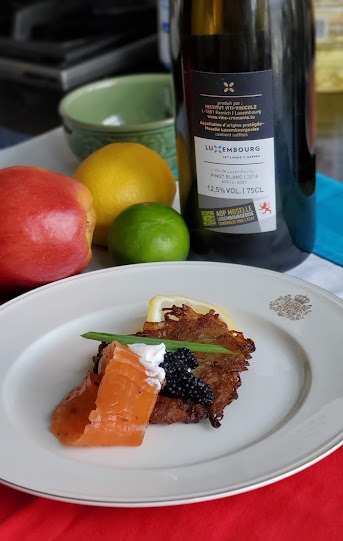
Another cherished dish of Luxembourg is Bouneschlupp. It is a soup consisting of green beans and potatoes with bacon or pork sausage. Depending on which region you are in Luxembourg, the thick soup may vary to include carrots, celery, leeks, onions, milk and cream.
Many people in Luxembourg consider Rieslingspaschtéit, a meat pâté in dough, as a culinary tradition. Pâté is a common paste made from meat, which is spreaded on bread and often eaten with pickles. This log-shaped meat pie is made by encasing a coarse pork pâté or terrine in a Riesling-flavored aspic and then baked in pastry. Rieslingspaschteit is seen as the queen of pies in Luxembourg and you can find them in practically every bakery across the country. People enjoy this delicious and hearty pie served cold and sliced and, preferably, with a nice glass of Riesling.
Some may consider Judd mat Gaardebounen as the national food of Luxembourg. This hefty and heart-warming dish is smoked pork collar (Judd) with big fava beans (Gaardebounen). The recipe calls for the smoked pork neck to be soaked overnight in water. The next day, it is placed in a pot with vegetables and spices like bay leaves and cloves, and then cooked over low heat for several hours until it is soft and tender. When the meat is ready, it is cut into thick slices and placed on a bed of creamy broad beans and potatoes.
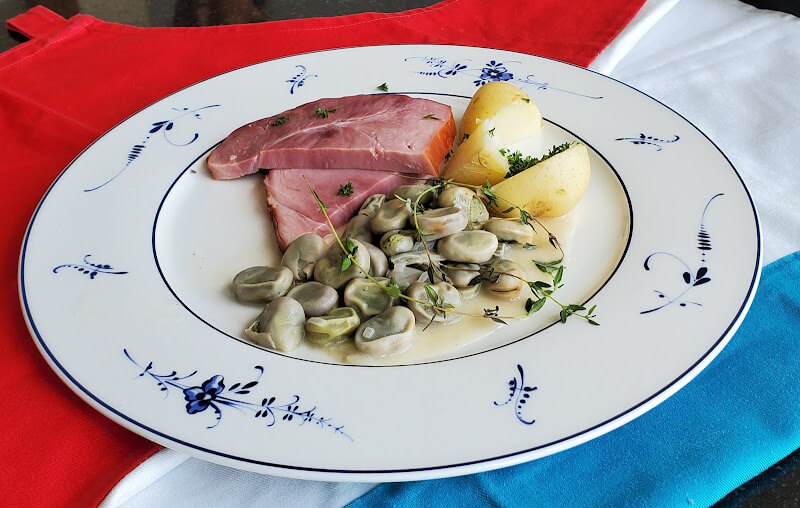
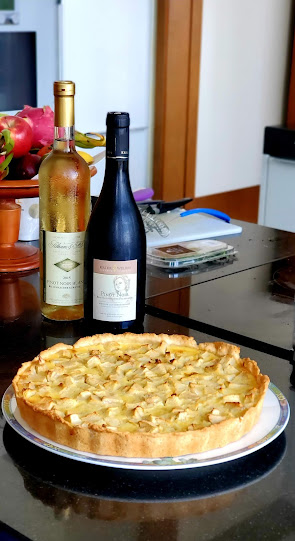
As our interview draws to a close, Madame Louise enthused, “Luxembourg is a small country. Our traditional food has evolved, and refined without losing its roots, it is still very much recognizable, but with a touch of new and maybe a little lighter.”



